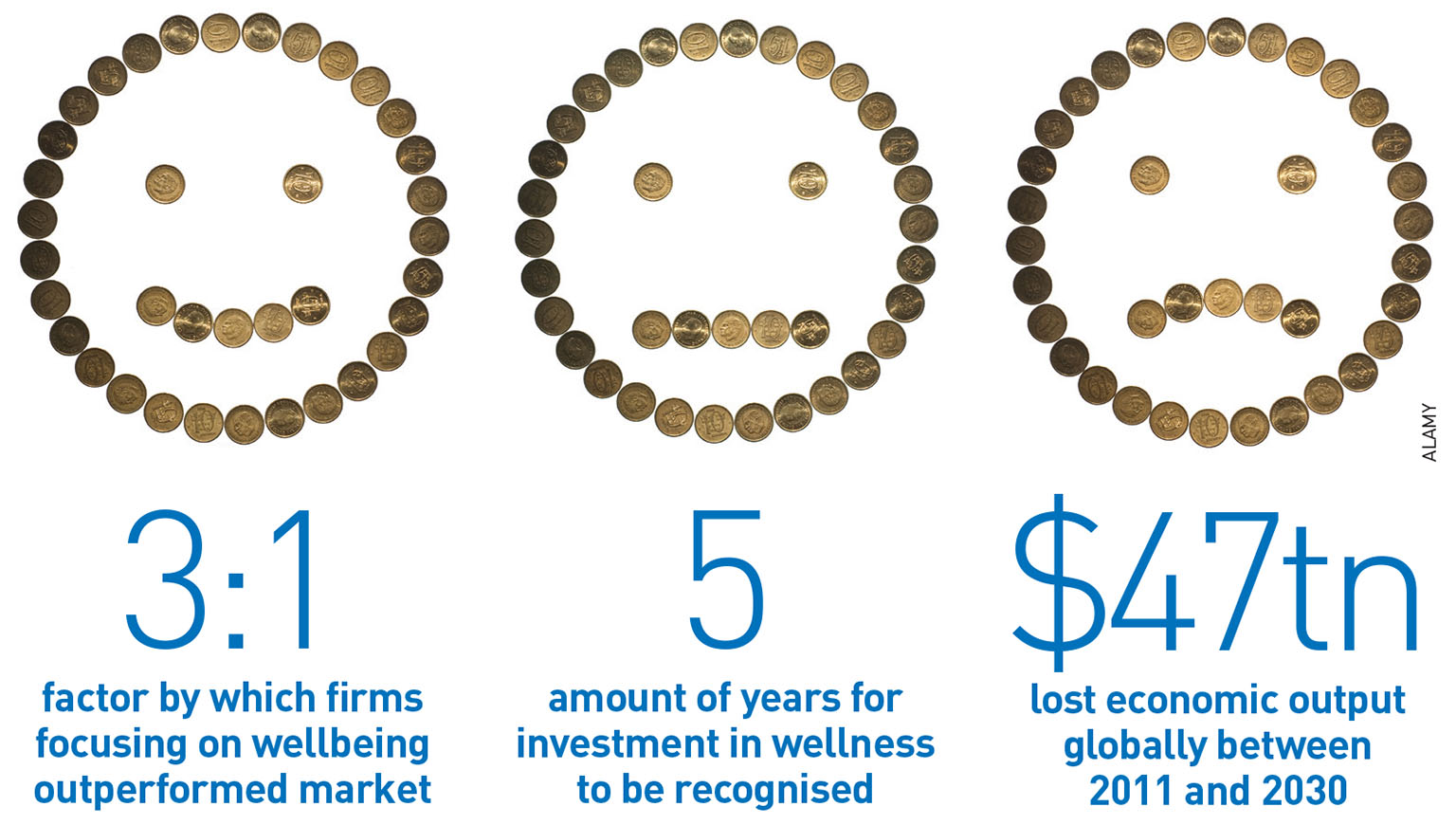It all adds up. By focusing on employee wellbeing and happiness, not only do companies boost productivity and save on sickness absence, but increase their own value, writes Samantha McClary
Let’s start with a number. A big number. More than $960bn (£665bn). It is a figure that surpasses the GDPs of all but the top 15 countries and is the estimated cost to business of work-related stress around the world.
In Europe, that figure is $650bn, in the US $300bn, in Australia almost $4bn and in Canada just shy of $3bn.
And the numbers don’t stop there. When it comes to wellness and the cost of the lack of attention to it, the figures abound.
There are 3.2bn workers in the world and they are becoming increasingly unwell. The economic burden of this in both medical expenses and lost productivity is enormous, potentially reaching 10-15% of global economic output.
Cost of illness
In the US alone, the cost of chronic illness, work-related injury, illness and stress, coupled with employee disengagement, exceeds $2.2tn a year, reflecting a not insignificant 12% of GDP.
The World Economic Forum and Harvard School of Public Health estimate that major chronic diseases and mental illness will result in a cumulative $47tn of lost economic output globally between 2011 and 2030.
Productivity losses due to poor health and presenteeism are even higher than the direct costs of medical treatment – $2.30 in lost productivity for every $1 in medical costs. In the US, missed workdays due to chronic illness cost employers $153bn in lost productivity every year. Adding presenteeism pushes that figure to a whopping $1.1tn.
And according to the World Health Organisation and International Labour Organisation, work-related accidents, occupational diseases and other work-related health problems account for economic losses in the range of 4-6% of the globe’s $78tn GDP.
So, $3-$5tn is the cost to business of failing to address wellness in the workplace, but what about the value of addressing it? Is money spent on implementing wellness programmes and office design worth it? Can wellness add value? And if so, how?
Focusing on wellness
The value of the global wellness market is $3.4tn, some three times bigger than the pharmaceuticals industry. That value, plus the knowledge that more and more of us are spending more and more time working, has led to the launch of several certifications for businesses, and now buildings, to show they are focusing on wellness. Paul Scialla, the founder of one of those certifications, the Well Standard, claims that having the Well stamp on a building will boost its commercial value, but what about for the occupier? How will they be convinced to pay extra rent for a building designed or run with wellness in mind?
One of the most compelling arguments for the commercial value of wellness is based around recruitment.
According to a survey by YouGov and developer and contractor Lend Lease, almost half of Londoners would be attracted to a new employer by high-quality offices or a focus on health and wellbeing.
“With talent retention and recruitment the number one priority for businesses, there is a growing focus on prioritising staff and their wellness and general wellbeing in the workplace,” says Jon Gardiner, head of South East and Greater London office agency at Savills.
“The pendulum of power has swung over recent years, with employees having a choice about where they work and basing their employment decisions not just on salary and incentives but the overall package, with elements such as environment, location, benefits and culture all being key factors in deciding where and for whom they work,” he adds.
“The inclusion of showers and cycle storage, as well as amenities such as an on-site gym or canteen and social aspects such as workplace events, are now an automatic part of the consideration process for an employee.”
Work/life balance
At the 2m sq ft Chiswick Park in west London, there has been a focus on wellbeing for 15 years. Its Enjoy Work brand is all about providing a work/life balance for tenants and includes activities such as one-to-one health clinics, free bike hire, language classes and free-to-use deck chairs around the lake so workers and visitors to the park can relax and unwind. There are also on-site gyms, plenty of green space and a host of weekly events.
The scheme is regularly recognised in the Great Places to Work Institute’s top 50 best places to work in the UK.
Graham White, chief executive of Enjoy Work, says the programme means everything to tenants at the park, 97% of whom say it adds value. And from a landlord’s perspective, it is a draw for occupiers.
White says Chiswick Park’s focus on the premise that if people enjoy work, they work better was one of the main reasons that global food company Danone recently chose to open its 42,000 sq ft UK HQ at the park.
Jack Stacy, senior portfolio manager at Chiswick Park owner Blackstone, also attributes the high tenant retention rate to Enjoy Work and says it is one of three key selling points made in pitches to potential new tenants, alongside quality of building and quality of the masterplanning.

“The Enjoy Work brand has taken a proactive approach that considers every aspect of the working day and on-park experience,” adds Savills’ Gardiner. “The masterplan puts the workforce at the heart of its design, with 12 buildings orientated inwards, which, when coupled with the Enjoy-Work service culture, makes for a unique environment, to which occupiers are immediately drawn.”
Stacy says that while the most progressive landlords will focus increasingly on the wellbeing of their tenants’ employees, he admits it is not always easy to make it commercially valuable.
“Procurement and economy of scale are important,” he says, adding that because of Chiswick Park’s size – it has more than 45 businesses and 8,000 employees on site – the costs it has to pass on to occupiers as a result of services can be lower than for many of its competitors.
Gardiner says higher building and estates charges are not an issue for tenants at the park, claiming that most of them focus on the higher value added through employee happiness and overall wellbeing.
Positive impact
Employee happiness is great, but if a business is investing in making its staff enjoy work, surely it needs to have some positive impact on a company’s financial value.
According to Alex Edmans, professor of finance at the London School of Business, it does – and a significant value.
Looking back over almost three decades of data, Edmans found that companies with high employee satisfaction outperformed their peers by between 2.3% and 3.8% a year in long-run stock returns. That equates to 89% to 184% cumulatively. A return not to be sniffed at.
A study in the Journal of Occupational and Environmental Medicine also points to the commercial value of wellness. It found that companies that nurtured a culture of health by specifically focusing on wellbeing outperformed the stock market by a factor of 3:1 between 2000 and 2014.
Edmans says the results of his study contradict conventional wisdom, which uses cost control as a measure of efficiency, but says he believes the benefits of employee satisfaction outweigh the costs. However, he does warn that it is a long game.
“My research indicates that it typically takes four to five years for investment in employee wellbeing to be reflected in a company’s share price,” says Edmans. “Promoting intangible investment requires lengthening the horizon of performance measures, encouraging large, informed shareholders and revising accounting standards to define and quantify intangible investment.”
And the reason for the improvement in financial performance for companies that devote some capital to investing in employee wellness and satisfaction is attributed to both attracting (and retaining) quality talent and to a rise in productivity among workers.
Buildings that promote high performance can improve productivity by 12.5%, says the Global Wellness Institute, while the worst buildings can reduce productivity by 17.5%. And, according to data analyst Gallup, employees of firms that have a wellness programme in place miss 41% less work as a result of poor health and are 81% less likely to look for another job.
So, in a world where the average person will spend at least 90,000 hours working – that’s between one-third and half of our waking hours – a little investment in something that keeps us healthy and motivated could be the differentiating factor between what makes a truly successful business and what doesn’t.
And if the cost of work-related ill health is expected to be 4-6% of GDP globally; staff salaries account for 90% of business operating costs (rent is just 9%); and the value of wellness for a business is estimated to be a boost of 2-4% on its stock market value, the maths seems pretty clear.
It is well worth it.
To send feedback, email samantha.mcclary@estatesgazette.com or tweet @samanthamcclary or @estatesgazette

- Features editor’s comment: what is wellness?
- Briefing: Swapping the lift for the stairs
- All well and good: making the workplace more healthy
- Workplace wellness: the main players
- Healthy profit: the value of wellbeing in the office
- Buildings on the cutting edge
RELATED LINKS:
- Roundtable: building connectivity
- Shard leasing director James Goldsmith is leaving to take on the same role at 22 Bishopsgate, EC2
- City protects Pinnacle site from rights to light claims
- Boris approves 22 Bishopsgate
- Sir Stuart Lipton talks to Damian Wild about the new thinking behind 22 Bishopsgate, government failures, and a rethink on Silvertown Quays
- Lipton’s City comeback puts people first












